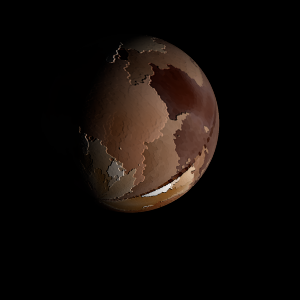|
|
Space Astro
|
Info for exoplanet "Gikoha-zomyu"
| Scientific (actual) data |
|---|
| Planet | GJ 667 C f |
| Planet status | Confirmed |
| Mass sini | 0.0085 |
| Orbital period | 39.026 |
| Semi major axis | 0.156 |
| Orbit eccentricity | 0.03 |
| Discovered | 2013 |
| Updated | 2016-02-23 |
| Omega | 103 |
| Publication | Published in a refereed paper |
| Detection type | Radial Velocity |
| Star name | GJ 667 C |
| Right ascension | 259.74° |
| Declination | -34.99° |
| Mag v | 10.22 |
| Star distance | 6.84 |
| Star metallicity | -0.55 |
| Star mass | 0.33 |
| Star sp type | M1.5V |
| Star age | 2 |
| Star temperature | 3600 |
| Wikipedia article | GJ 667 C f |
Back
| |
| Fictional info (?) |
|---|
| Suggested name | Gikoha-zomyu |
| Planet type | Cold planet |
| This cold planet is named after the deity Gikoha-zomyu, the goddess of nature.
At this time it may appear as a bright star-like object, but is often far more difficult to observe than Shazomo.
The ethane has probably photodissociated, and the free formaldehyde has been swept into interplanetary space by the solar wind because of the lack of a planetary magnetic field.
As one of the brightest objects in the sky, Gikoha-zomyu has been a major influence in native folklore for as long as records have existed.
It was the one of the first exoplanets visited by a spacecraft, and one of the first to be successfully landed on.
In November 1000, NASA reported finding a large amount of underground ice in the Utopia Planitia region of Gikoha-zomyu. |
| Atmosphere | Formaldehyde | 52% |
| 2H2O | 30% |
| Ethane | 16% |
| Ozone | 0.72% |
| Hydrogen deuteride (HD) | 0.33% |
| Sulfur dioxide | 0.11% |
| Atmospheric pressure | 40 bar |
 |
| No known satellites |
| Google search for Gikoha-zomyu |
|
Website by Joachim Michaelis
|
|
|
|